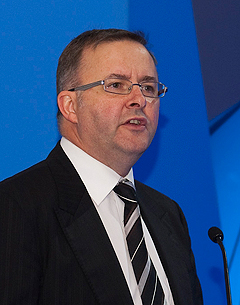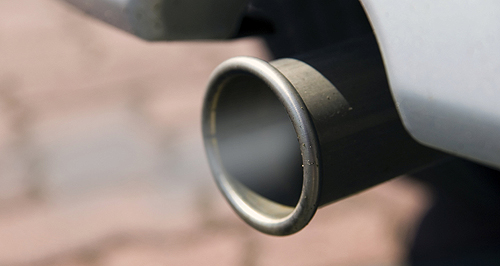News - General NewsMinister backtracks on bullish Euro 5/6 planLet's talk: Tougher vehicle pollution regulations may be delayed, with the federal government agreeing to talk. Federal government softens stance on tough new mandatory emissions standards timing7 May 2010 By TERRY MARTIN THE federal government has softened its stance on the introduction of tough new mandatory emissions standards, now agreeing to “discuss adjustments to the timeframe” which were recommended to be 2012 for the Euro 5 standard and 2016 for Euro 6. As GoAuto reported exclusively in February, the Australian car industry railed against the proposed timetable, with the Federal Chamber of Automotive Industries (FCAI) arguing that it put the viability of local engine plants at risk and threw future model programs into disarray. After receiving more than two dozen submissions responding to the Euro 5/6 regulation impact statement (RIS) – a document which urged that Euro 5 take effect less than two years after the final July 1, 2010, deadline for Euro 4 – Mr Albanese has indicated that the proposed dates will now be extended. “Many of the responses favour the introduction of Euro 5/6 as proposed in the draft RIS, but I do recognise that some in the industry have some reservations about the timing of the implementation,” Mr Albanese told the FCAI at its annual dinner in Melbourne this week. “The government is willing to discuss adjustments to the timeframe with the FCAI which could help to minimise compliance costs while maintaining air quality benefits. “But the government expects industry to show leadership and embrace the purpose and intent of the change and not substitute prevarication for action.  Left: Federal transport minister Anthony Albanese. Left: Federal transport minister Anthony Albanese.“In my view, it is important to have these issues resolved quickly so that the industry has maximum time to plan for compliance. I am confident the FCAI will work with the government and show leadership to achieve healthier air quality for our major cities.” FCAI chief executive Andrew McKellar told GoAuto that he did not characterise Mr Albanese’s comments as bowing to car industry pressure, but said he was pleased with the minister’s response to submissions opposing the RIS. “What’s been acknowledged is that the original analysis that was contained in the RIS only presented a limited perspective,” he said. “The industry’s submissions have highlighted that the timetables that were proposed in the RIS didn’t take account of anything to do with product availability, model development cycles, or future investment decisions in relation to the engine plants that the industry has here in Australia. “All of those things are relevant considerations that have an impact on what is achievable. I’d be pretty confident that at the end of the day we can come up with something that is ambitious, and which will see those standards implemented, but there may need to be some flexibility on the timetables and the options that were put forward in the RIS. “The point that has been made to the industry is that for anything to be considered, the case has got to be substantiated. Well, I think that’s what we’re in the process of doing, and I’m confident we’ll get a fair and reasonable outcome out of that process.” A spokesperson for Mr Albanese told GoAuto that a decision on the RIS should materialise “soon” – “it will be made in a short period of time” – as would proposed new 2015 target for CO2 emissions under the National Average Carbon Emission (NACE) scheme. This will be subject of a separate RIS. The industry easily achieved its 2010 target of 222gkm – indeed, it reached that mark in 2008 – and last year recorded a figure of 218.5g/km. GoAuto understands that the government will propose a new mandatory 2015 CO2 target of 195g/km – a figure that Mr McKellar said was in line with the car industry’s expectations. “We’ve done our own analysis – in fact, we’ve commissioned two separate reports – and they’ve both ended up in a similar ballpark,” Mr McKellar said. “It doesn’t matter which way you cut it. When you look at the technologies that are on the table, when you look at the composition of the Australian fleet, and when you make some pretty fair and reasonable assumptions about further segmentation change, then you’re likely to come up with a very similar result.” In his maiden speech as the FCAI’s new president, GM Holden chairman Mike Devereux told Mr Albanese and FCAI members attending the annual dinner that the industry “was serious about combating the impact of climate change” and supported the introduction of Euro 5/6, but was concerned about the proposed timetable. “My message to government, on behalf of the industry, is that we are serious about combating the impact of climate change and we are here to take action to ensure the best outcome for the environment, the customer and the industry,” Mr Devereux said. “We do support the introduction of Euro 5/Euro 6 emissions standards, but equally understand the importance of taking into account future product plans, the model development cycle, and the need to safeguard future investment in Australian engine plant operations.” The new Holden chief, who arrived last month from his post as chairman of GM’s Middle East operations, said his impressions were that the Australian industry was working hard on reducing emissions “regardless of regulations”. “From everything I see, the industry has worked hard to lower emissions regardless of regulations. And as car-makers, our natural rivalry means that no one wants to be left behind in the race to bring the new technology into the market,” he said. “We are competitive beasts. No one manufacturer wants to be seen in the eyes of the consumer as the brand that isn’t at the cutting edge. “In the long-term, the community and the environment are better off with a robust, competitive marketplace.” In announcing the draft Euro 5/6 RIS in January under the headline ‘New, tougher pollution emissions standards for vehicles’, Mr Albanese said the new regulations would cut emissions from all new cars, 4WDs and utes sold in Australia “by as much as 90 per cent”. “The more stringent mandatory emission standards being put forward by the Rudd Labor government target the pollutants responsible for the formation of smog over our major cities and health problems within our population,” he said. “Compared to the current regulatory regime, the proposed new standards – Euro 5 from 2012 and Euro 6 from 2016 – would cut a new vehicle's maximum emissions of hydrocarbon by up to 50 per cent, oxides of nitrogen by up to 70 per cent, and particulate matter by up to 90 per cent. “Euro 5 and Euro 6 standards have already been adopted by the European Union. The draft regulation impact statement I'm releasing today lays out the costs and benefits of Australia following suit. “Over time the new standards would lead to cleaner skies and healthier air quality. “While the air quality in our major cities has improved significantly in recent years, the growth in the number of vehicles means we must continually monitor our standards and where possible deploy new, more effective technologies. “For example, Sydney still records as many as 25 high pollution days a year. “Australia's mandatory vehicle emission standards together with stringent fuel quality standards are widely recognised as the most cost-effective way of improving urban air quality. Both have been progressively tightened over the past 30 years.”  Read more6th of May 2010  FCAI president urges EV supportHolden chief, in new role as FCAI president, calls for government EV support30th of March 2010  Better fuel quality not required, says petrol industryOil industry refutes claims that fuel quality must improve to meet Euro 5/615th of March 2010  Brits make big inroads into CO2 car emissionsAverage new-car CO2 emissions in UK fall 5.4 per cent to less than 150g/km1st of March 2010  New-car CO2 emissions under reviewAustralia is on the right road to reducing CO2, but are the targets tough enough? |
Click to shareGeneral News articlesResearch General News Motor industry news |
















Facebook Twitter Instagram